Abnormal-Trajectory Detection Method Based on Variable Grid Partitioning
Abstract
1. Introduction
- (1)
- Classification-based methods
- (2)
- Distance-based methods
- (3)
- Historical similarity-based methods
- (4)
- Grid-based methods
- (5)
- Other methods
2. Methods
2.1. Basic Concepts and Problem Description
2.2. Variable-Grid-Based Abnormal-Trajectory Detection Method
2.2.1. Road Network Density Analysis
2.2.2. Trajectory Sequencing
2.2.3. Abnormal-Trajectory Detection
- (1)
- Calculation of the trajectory abnormality degree
| Algorithm 1: Zone benchmark grid number acquisition |
| Input: Original trajectory dataset TD, network coding number matrix Gn; Output: Number of zone datum grids , , ; matrix MT 1: NSG←min(Gn(:,5)); 2: k←0, q←0, r←0; 3: ST←, HT←, MT←; 4: for i←1 to |TD| 5: if Gn(i,5) == NSG 6: k←k + 1; 7: ST(k,:)←Gn(i,:); 8: end if 9: end for 10: ←max(ST(:,2)); 11: for i←1 to |ST| 12: if ST(i,2) == 13: q←q + 1; 14: HT(q,:)←ST(i,:); 15: end if 16: end for 17: ←max(HT(:,3)); 18: for i←1 to |HT| 19: if HT(i,3) == 20: r←r + 1; 21: MT(r,:)←HT(i,:); 22: end if 23: end for 24: ν←MT(1,4); 25: return , , , MT |
| Algorithm 2: Trajectory abnormality degree calculation |
| Input: network coding number matrix Gn; matrix MT; Number of zone datum grids , , Output: The set of trajectory abnormality TP 1: TR←Gn-MT; 2: TP←; 3: for i←1 to |TR| 4: Calculate , , using Equations (5)–(7), respectively; 5: DAT←<, , >; 6: TP←TP DAT; 7: end for 8: return TP; |
- (2)
- Abnormal-trajectory rate acquisition and abnormal judgment
| Algorithm 3: Trajectory abnormality rate acquisition and abnormality judgment |
| Input: The set of abnormal trajectories TP; Trajectory abnormality threshold rat Output: Set of spatially abnormal trajectories TF 1: TF← ; 2: for i←1 to |TP| 3: Calculate , , and using Equations (8)–(10), respectively; 4: Calculate using Equation (11); 5: if 6: TF←TF TPi; 7: end if 8: end for 9: return TF; |
2.2.4. Motivating Example
3. Results
3.1. Trajectory Dataset
3.2. Road Network Density Analysis
3.3. Experimental Results
3.4. Varying Parameters
3.5. Comparative Evaluation
4. Discussion
5. Conclusions
Author Contributions
Funding
Institutional Review Board Statement
Informed Consent Statement
Acknowledgments
Conflicts of Interest
References
- Ranaweera, M.; Seneviratne, A.; Rey, D.; Saberi, M.; Dixit, V.V. Detection of anomalous vehicles using physics of traffic. Veh. Commun. 2021, 27, 100304. [Google Scholar] [CrossRef]
- Xia, F.; Wang, J.; Kong, X.; Wang, Z.; Li, J.; Liu, C. Exploring human mobility patterns in urban scenarios: A trajectory data perspective. IEEE Commun. Mag. 2018, 56, 142–149. [Google Scholar] [CrossRef]
- Qiao, Y.; Cheng, Y.; Yang, J.; Liu, J.; Kato, N. A mobility analytical framework for big mobile data in densely populated area. IEEE Trans. Veh. Technol. 2017, 66, 1443–1455. [Google Scholar] [CrossRef]
- Wang, Y.; Zheng, Y.; Xue, Y. Travel time estimation of a path using sparse trajectories. In Proceedings of the ACM SIGKDD International Conference on Knowledge Discovery and Data Mining, New York, NY, USA, 24–27 August 2014; pp. 25–34. [Google Scholar]
- Chiabaut, N.; Faitout, R. Traffic congestion and travel time prediction based on historical congestion maps and identification of consensual days. Transp. Res. Part C Emerg. Technol. 2021, 124, 102920. [Google Scholar] [CrossRef]
- Ning, Z.; Huang, J.; Wang, X. Vehicular fog computing: Enabling real-time traffic management for smart cities. IEEE Wirel. Commun. 2019, 26, 87–93. [Google Scholar] [CrossRef]
- Ding, Y.; Zhang, W.; Zhou, X.; Liao, Q.; Luo, Q.; Ni, L.M. FraudTrip: Taxi fraudulent trip detection from corresponding trajectories. IEEE Internet Things J. 2021, 8, 12505–12517. [Google Scholar] [CrossRef]
- Lu, E.H.-C.; Chen, H.S.; Tseng, V.S. An efficient framework for multirequest route planning in urban environments. IEEE Trans. Intell. Transp. Syst. 2017, 18, 869–879. [Google Scholar] [CrossRef]
- Tu, W. Real-Time route recommendations for E-Taxies leveraging GPS trajectories. IEEE Trans. Ind. Inform. 2021, 17, 3133–3142. [Google Scholar] [CrossRef]
- Gao, Q.; Zhang, F.L.; Wang, R.J.; Zhou, F. Trajectory big data: A review of key technologies in data processing. Ruan Jian Xue Bao/J. Softw. 2017, 28, 959–992. [Google Scholar]
- Wang, Y.; Qin, K.; Chen, Y.; Zhao, P. Detecting anomalous trajectories and behavior patterns using hierarchical clustering from Taxi GPS Data. ISPRS Int. J. Geo-Inf. 2018, 7, 25. [Google Scholar] [CrossRef]
- Qin, G.; Huang, Z.; Xiang, Y.; Sun, J. ProbDetect: A choice probability-based taxi trip anomaly detection model considering traffic variability. Transp. Res. Part C Emerg. Technol. 2019, 98, 221–238. [Google Scholar] [CrossRef]
- Zhao, X.; Su, J.; Cai, J.; Yang, H.; Xi, T. Vehicle anomalous trajectory detection algorithm based on road network partition. Appl. Intell. 2022, 52, 8820–8838. [Google Scholar] [CrossRef]
- Tao, L.; Zhu, D.; Yan, L.; Zhang, P. The traffic accident hotspot prediction: Based on the logistic regression method. In Proceedings of the ICTIS 2015—3rd International Conference on Transportation Information and Safety, Wuhan, China, 25–28 June 2015; pp. 107–110. [Google Scholar]
- Kim, T.; Taylor, S.; Yue, Y.; Matthews, I. A decision tree framework for spatiotemporal sequence prediction. In Proceedings of the ACM SIGKDD International Conference on Knowledge Discovery and Data Mining, Sydney, Australia, 10–13 August 2015; pp. 577–586. [Google Scholar]
- Piciarelli, C.; Micheloni, C.; Foresti, G.L. Trajectory-based anomalous event detection. IEEE Trans. Circuits Syst. Video Technol. 2008, 18, 1544–1554. [Google Scholar] [CrossRef]
- Knorr, E.M.; Ng, R.T.; Tucakov, V. Distance-based outliers: Algorithms and applications. VLDB J. 2000, 8, 237–253. [Google Scholar] [CrossRef]
- San Román, I.; de Diego, I.M.; Conde, C.; Cabello, E. Outlier trajectory detection through a context-aware distance. Pattern Anal. Appl. 2019, 22, 831–839. [Google Scholar] [CrossRef]
- Lee, J.G.; Han, J.; Li, X. Trajectory outlier detection: A partition-and-detect framework. In Proceedings of the International Conference on Data Engineering, Urbana, IL, USA, 7–12 April 2008; pp. 140–149. [Google Scholar]
- Yu, Y.; Cao, L.; Rundensteiner, E.A.; Wang, Q. Detecting moving object outliers in massive-scale trajectory streams. In Proceedings of the ACM SIGKDD International Conference on Knowledge Discovery and Data Mining, New York, NY, USA, 24–27 August 2014; pp. 422–431. [Google Scholar]
- Qian, S.; Cheng, B.; Cao, J.; Xue, G.; Zhu, Y.; Yu, J.; Li, M.; Zhang, T. Detecting taxi trajectory anomaly based on spatio-temporal relations. Intell. Transp. Syst. 2022, 23, 6883–6894. [Google Scholar] [CrossRef]
- Mao, J.; Wang, T.; Jin, C.; Zhou, A. Feature grouping-based outlier detection upon streaming trajectories. IEEE Trans. Knowl. Data Eng. 2017, 29, 2696–2709. [Google Scholar] [CrossRef]
- Cormode, G.; Shkapenyuk, V.; Srivastava, D.; Xu, B. Forward decay: A practical time decay model for streaming systems. In Proceedings of the International Conference on Data Engineering, Las Vegas, NV, USA, 22–24 June 2009; pp. 138–149. [Google Scholar]
- Li, X.; Li, Z.; Han, J.; Lee, J.G. Temporal outlier detection in vehicle traffic data. In Proceedings of the International Conference on Data Engineering, Shanghai, China, 29 March–2 April 2009; pp. 1319–1322. [Google Scholar]
- Zhang, D.; Li, N.; Zhou, Z.H.; Chen, C.; Sun, L.; Li, S. iBAT: Detecting anomalous taxi trajectories from GPS traces. In UbiComp’11, Proceedings of the 2011 ACM Conference on Ubiquitous Computing, Beijing, China, 17–21 September 2011; Association for Computing Machinery: New York, NY, USA, 2011; pp. 99–108. [Google Scholar]
- Wang, J.; Yuan, Y.; Ni, T.; Ma, Y.; Liu, M.; Xu, G.; Shen, W. Anomalous trajectory detection and classification based on difference and intersection set distance. IEEE Trans. Veh. Technol. 2020, 69, 2487–2500. [Google Scholar] [CrossRef]
- Yu, Q.; Luo, Y.; Chen, C.; Wang, X. Trajectory outlier detection approach based on common slices sub-sequence. Appl. Intell. 2018, 48, 2661–2680. [Google Scholar] [CrossRef]
- Wu, Z.; Li, Y.; Wang, X.; Su, J.; Yang, L.; Nie, Y.; Wang, Y. Mining factors affecting taxi detour behavior from GPS traces at directional road segment Level. IEEE Trans. Intell. Transp. Syst. 2022, 23, 8013–8023. [Google Scholar] [CrossRef]
- Silverman, B.W. Density estimation for statistics and data analysis. Wiley R. Stat. Soc. 2016, 150, 403–404. [Google Scholar]
- Piorkowski, M.; Sarafijanovic-Djukic, N.; Grossglauser, M. CRAWDAD. (v. 2009-02-24). Available online: https://crawdad.org/epfl/mobility/20090224 (accessed on 1 March 2021).
- Fu, C.; Huang, H.; Weibel, R. Adaptive simplification of GPS trajectories with geographic context–a quadtree-based approach. Int. J. Geogr. Inf. Sci. 2021, 35, 661–688. [Google Scholar] [CrossRef]
- Lee, W.; Cho, S.W. AIS Trajectories Simplification Algorithm Considering Topographic Information. Sensors 2022, 22, 7036. [Google Scholar] [CrossRef] [PubMed]
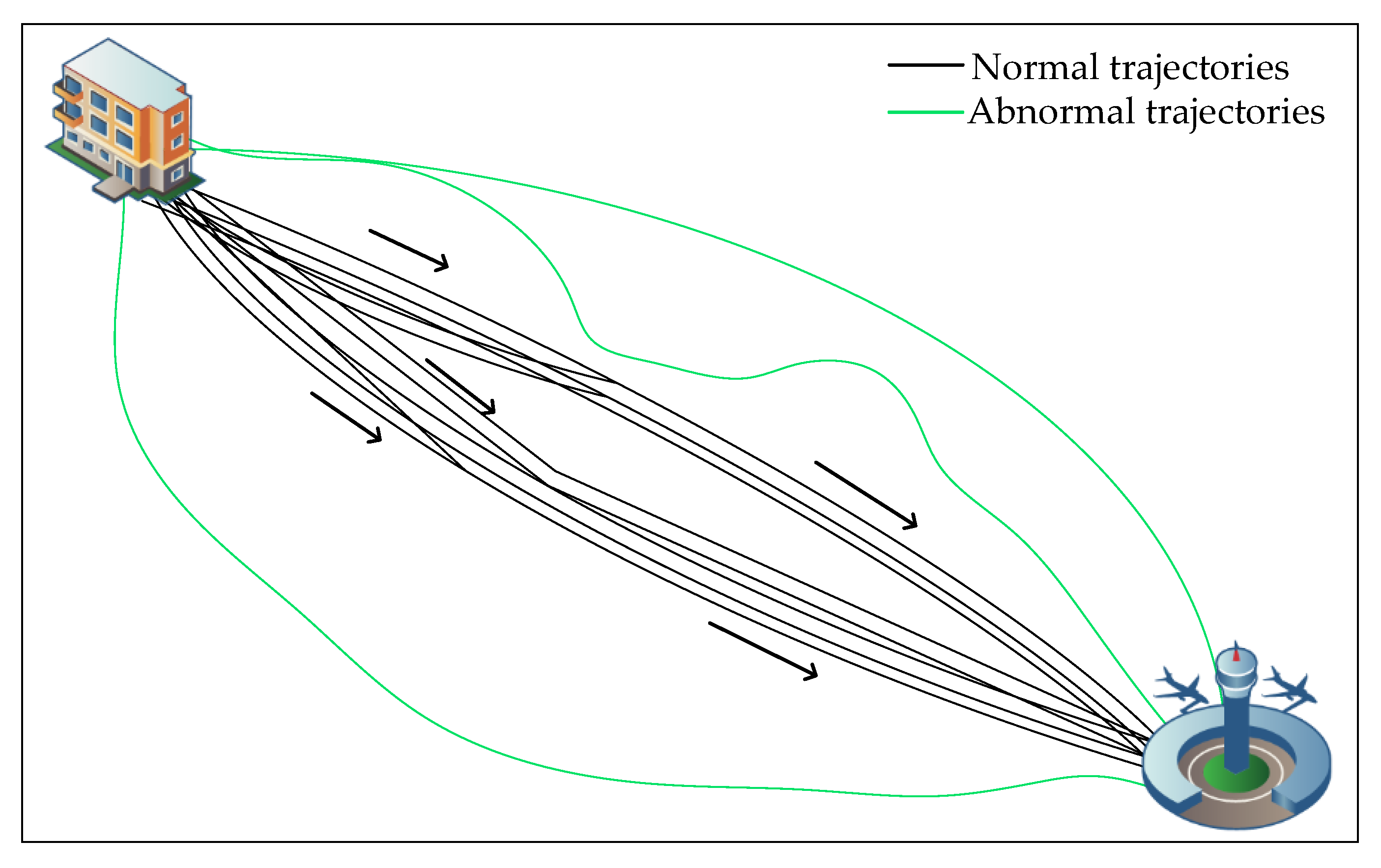
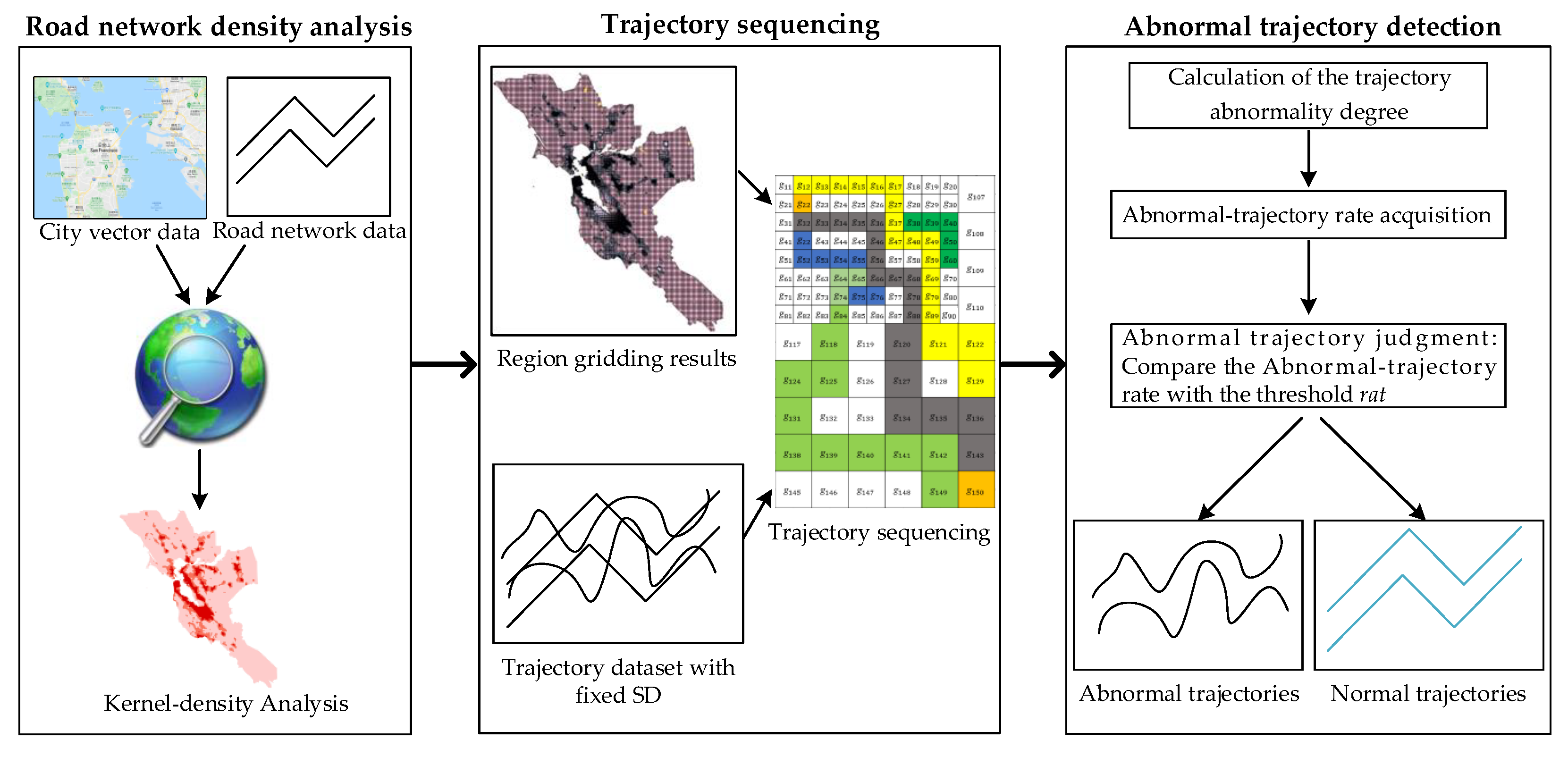
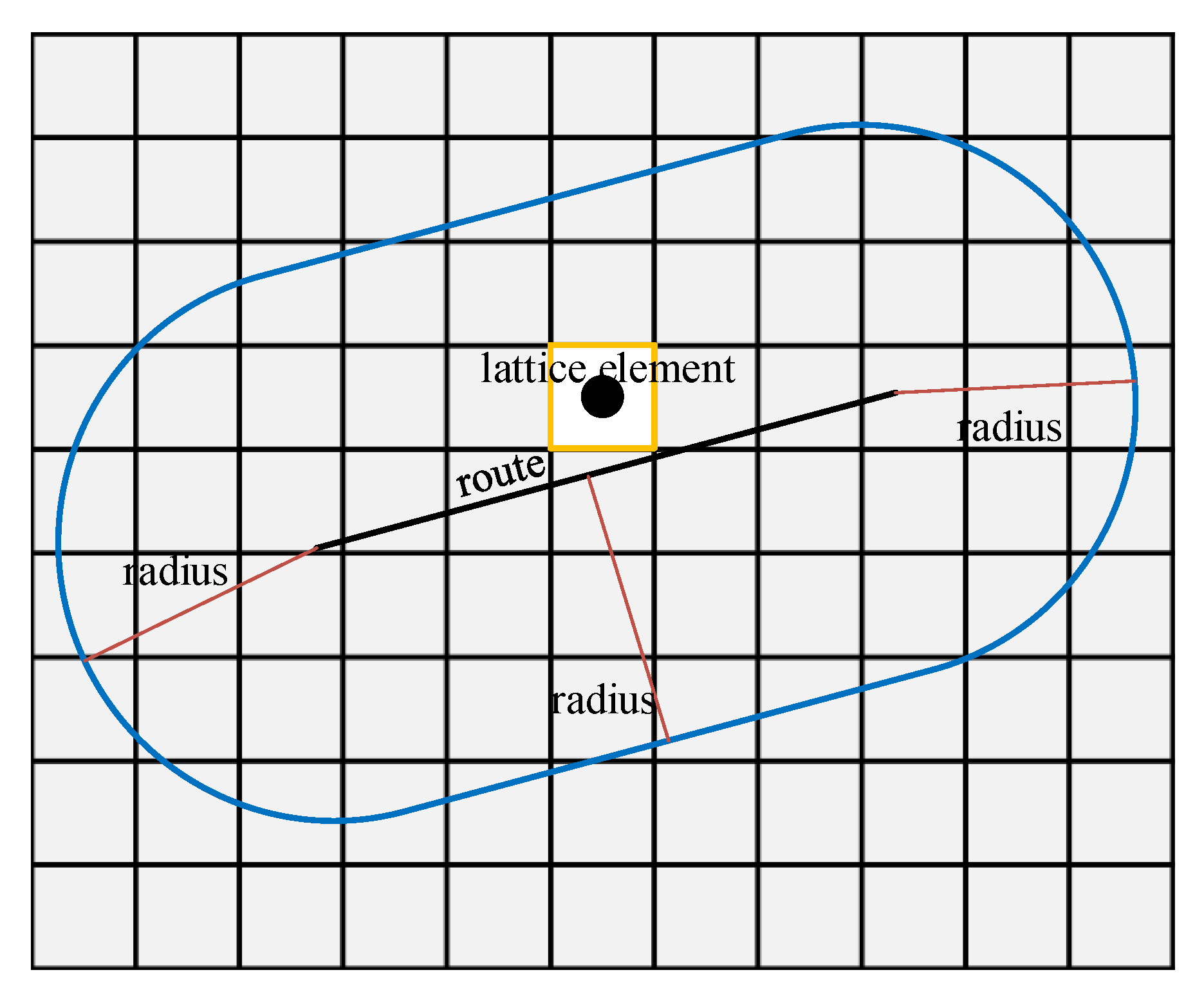
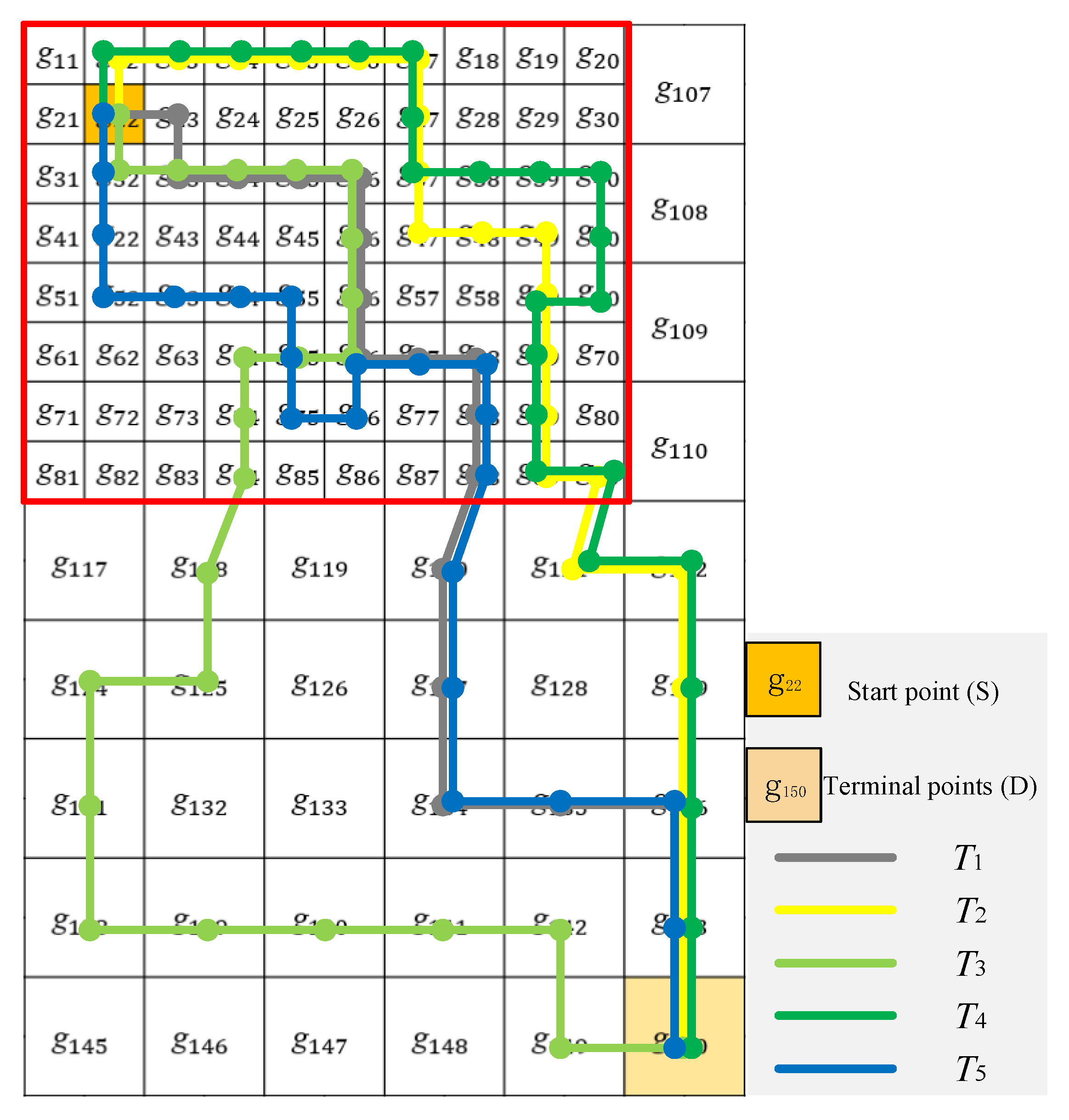
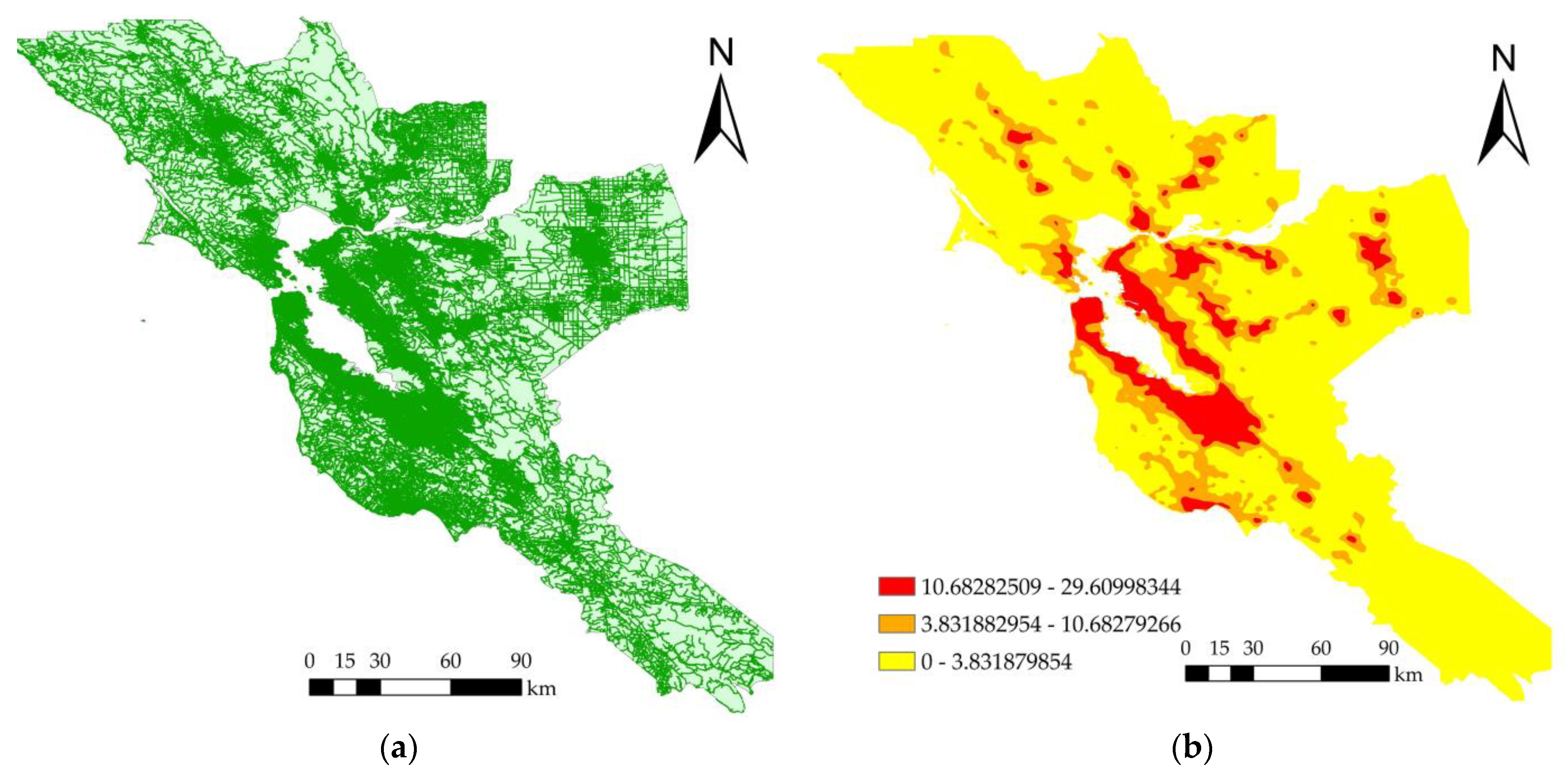

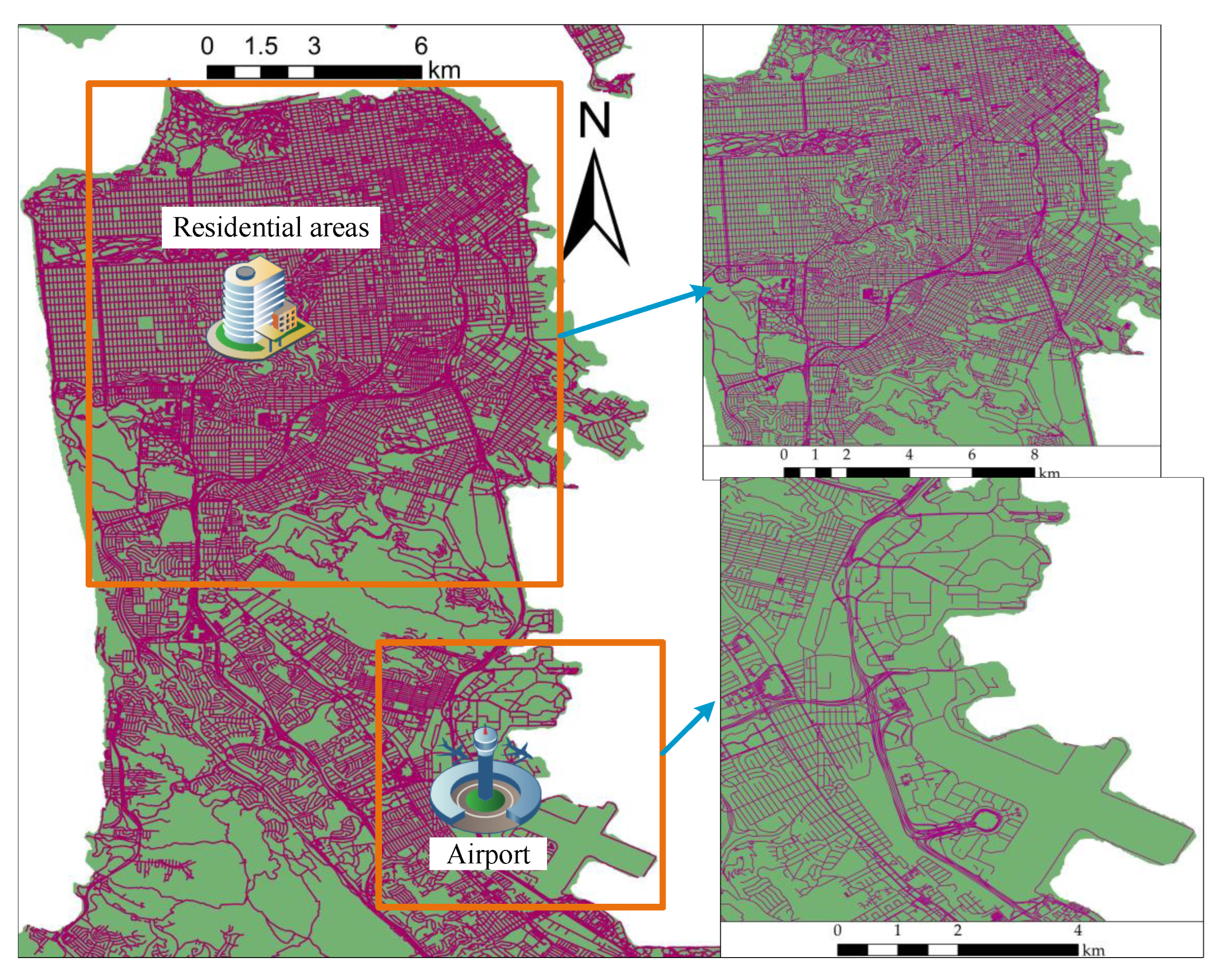
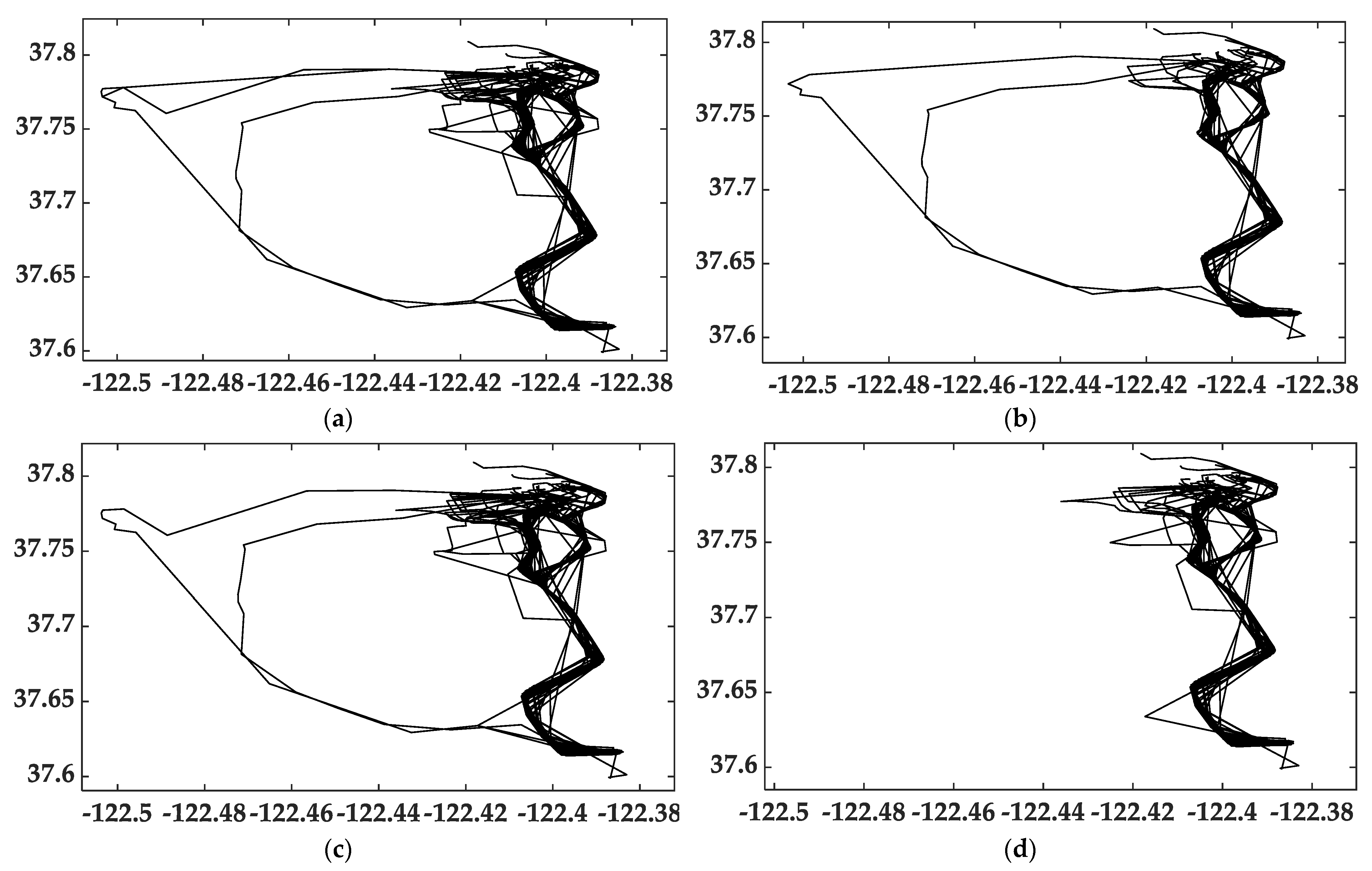
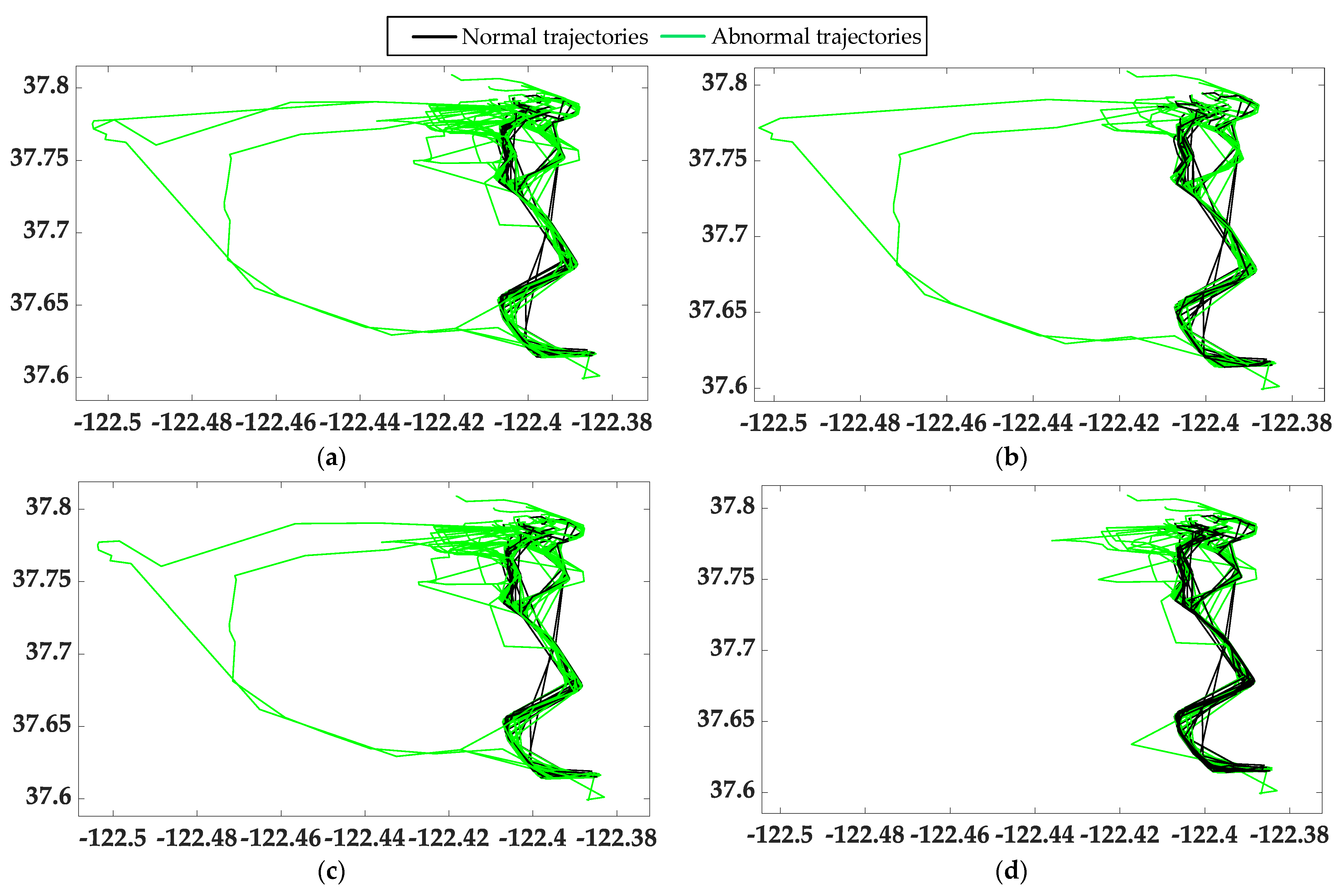


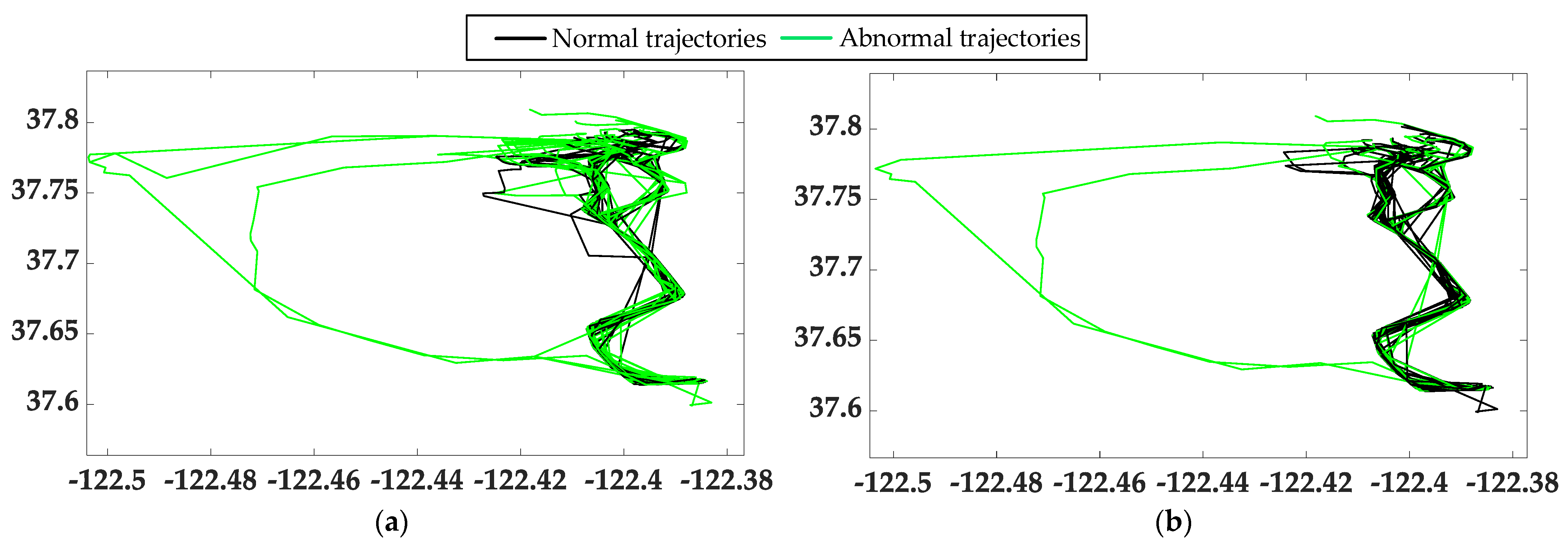

| Symbols | Definition |
|---|---|
| TF | Abnormal-trajectory dataset |
| ST | Standard trajectory set |
| TC | Combination of grid codes through which the trajectory passes in each density region |
| NBG | Number of grid codes |
| DAT | Trajectory abnormality |
| TAR | Trajectory abnormality rate |
| ,, and | High-, medium-, and low-density road network region weights |
| TAP | Probability of trajectory abnormality |
| rat | Trajectory abnormality threshold |
| TR | Dataset after removal of the benchmark trajectory set |
| Trajectory | Trajectory Tuple |
|---|---|
| 13 | 17 | 13 | 19 | 15 | |
| 7 | 6 | 11 | 6 | 7 | |
| NBG | 20 | 23 | 24 | 25 | 22 |
| 0 | 4 | 0 | 6 | 2 | |
| 0 | −1 | 4 | −1 | 0 |
| 0 | 0.308 | 0 | 0.462 | 0.152 | |
| 0 | −0.143 | 0.572 | −0.143 | 0 |
| 0 | 0.1276 | 0.2288 | 0.22 | 0.0912 |
| Data Sets | ATDVG | ATDC | iBAT |
|---|---|---|---|
| T-1 | 0.9900 | 0.9617 | 0.6383 |
| T-2 | 0.9900 | 0.9801 | 0.7243 |
| T-3 | 0.9867 | 0.9333 | 0.3400 |
| T-4 | 0.9934 | 0.9236 | 0.7276 |
| Data Sets | ATDVG | ATDC | iBAT |
|---|---|---|---|
| T-1 | 0.9789 | 0.9452 | 0.6115 |
| T-2 | 0.9850 | 0.9709 | 0.7489 |
| T-3 | 0.9540 | 0.8929 | 0.3028 |
| T-4 | 0.9949 | 0.9130 | 0.7090 |
| Data Sets | ATDVG | ATDC | iBAT |
|---|---|---|---|
| T-1 | 1 | 0.9753 | 0.6396 |
| T-2 | 1 | 1 | 0.8800 |
| T-3 | 1 | 0.8721 | 1 |
| T-4 | 0.9949 | 0.9742 | 0.9794 |
Disclaimer/Publisher’s Note: The statements, opinions and data contained in all publications are solely those of the individual author(s) and contributor(s) and not of MDPI and/or the editor(s). MDPI and/or the editor(s) disclaim responsibility for any injury to people or property resulting from any ideas, methods, instructions or products referred to in the content. |
© 2023 by the authors. Licensee MDPI, Basel, Switzerland. This article is an open access article distributed under the terms and conditions of the Creative Commons Attribution (CC BY) license (https://creativecommons.org/licenses/by/4.0/).
Share and Cite
Chen, C.; Xu, D.; Yu, Q.; Gong, S.; Shi, G.; Liu, H.; Chen, W. Abnormal-Trajectory Detection Method Based on Variable Grid Partitioning. ISPRS Int. J. Geo-Inf. 2023, 12, 40. https://doi.org/10.3390/ijgi12020040
Chen C, Xu D, Yu Q, Gong S, Shi G, Liu H, Chen W. Abnormal-Trajectory Detection Method Based on Variable Grid Partitioning. ISPRS International Journal of Geo-Information. 2023; 12(2):40. https://doi.org/10.3390/ijgi12020040
Chicago/Turabian StyleChen, Chuanming, Dongsheng Xu, Qingying Yu, Shan Gong, Gege Shi, Haoming Liu, and Wen Chen. 2023. "Abnormal-Trajectory Detection Method Based on Variable Grid Partitioning" ISPRS International Journal of Geo-Information 12, no. 2: 40. https://doi.org/10.3390/ijgi12020040
APA StyleChen, C., Xu, D., Yu, Q., Gong, S., Shi, G., Liu, H., & Chen, W. (2023). Abnormal-Trajectory Detection Method Based on Variable Grid Partitioning. ISPRS International Journal of Geo-Information, 12(2), 40. https://doi.org/10.3390/ijgi12020040





